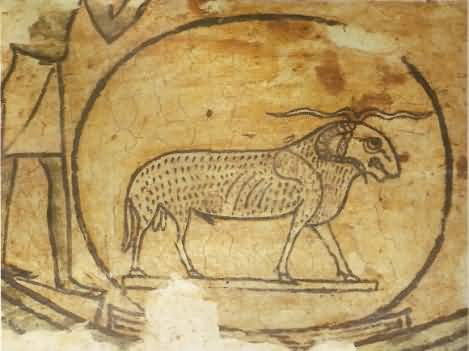
Amun
An Egyptian deity who combined with the sun god to become Amun-Re, Amun was paramount in the Egyptian pantheon during the height of the pharaonic empire. He was an anthropomorphic god sporting a crown of two tall plumes. His name means 'the Hidden One' and gives little clue to his vital personality.
He was also a war god, instigating attack and an impregnable bulwark for the defence of the royal warrior, being particularly associated with the military operations of Tuthmosis III (1479-1425 bce), when Egyptian dominion stretched from the Sudan to Syria, and with the less successful campaign of Rameses II (1290-1224 bce) against the Hittites. Scenes on the walls of the temples of Deir el Bahri and Luxor stress this close relationship.
The most magnificent of the many temples dedicated to Amun was that of Karnak at Eastern Thebes; every year the New Year festival procession left the precinct of Karnak to travel by road and river to Luxor, with the statue of Amun towed on a splendid 100-foot gilded barge.
Tacitus (Histories v. 4) speaks of ram-sacrifice by the Jews in honour of Jupiter Ammon. Also Herodotus (ii. 42) mentions the same in Egypt.

Amun, from an Egyptian mummy case, shown as a ferocious ram
From Herodotus The History. The Second Book: Euterpe
Such Egyptians as possess a temple of the Theban Jove, or live in the Thebaic canton, offer no sheep in sacrifice, but only goats; for the Egyptians do not all worship the same gods, excepting Isis and Osiris, the latter of whom they say is the Grecian Bacchus. Those, on the contrary, who possess a temple dedicated to Mendes, or belong to the Mendesian canton, abstain from offering goats, and sacrifice sheep instead. The Thebans, and such as imitate them in their practice, give the following account of the origin of the custom:—“Hercules,” they say, “wished of all things to see Jove, but Jove did not choose to be seen of him. At length, when Hercules persisted, Jove hit on a device—to flay a ram, and, cutting off his head, hold the head before him, and cover himself with the fleece. In this guise he showed himself to Hercules.” Therefore the Egyptians give their statues of Jupiter the face of a ram: and from them the practice has passed to the Ammonians, who are a joint colony of Egyptians and Ethiopians, speaking a language between the two; hence also, in my opinion, the latter people took their name of Ammonians, since the Egyptian name for Jupiter is Amun. Such, then, is the reason why the Thebans do not sacrifice rams, but consider them sacred animals. Upon one day in the year, however, at the festival of Jupiter, they slay a single ram, and stripping off the fleece, cover with it the statue of that god, as he once covered himself, and then bring up to the statue of Jove an image of Hercules. When this has been done, the whole assembly beat their breasts in mourning for the ram, and afterwards bury him in a holy sepulchre.
From Histories by Tacitus. BOOK IV, January — November, A.D. 70
Then the vestal virgins, with a troop of boys and girls, whose fathers and mothers were still living, sprinkled the whole space with water drawn from the fountains and rivers. After this, Helvidius Priscus, the praetor, first purified the spot with the usual sacrifice of a sow, a sheep, and a bull, and duly placed the entrails on turf; then, in terms dictated by Publius Aelianus, the high-priest, besought Jupiter, Juno, Minerva, and the tutelary deities of the place, to prosper the undertaking, and to lend their divine help to raise the abodes which the piety of men had founded for them. He then touched the wreaths, which were wound round the foundation stone and entwined with the ropes, while at the same moment all the other magistrates of the State, the Priests, the Senators, the Knights, and a number of the citizens, with zeal and joy uniting their efforts, dragged the huge stone along. Contributions of gold and silver and virgin ores, never smelted in the furnace, but still in their natural state, were showered on the foundations.
